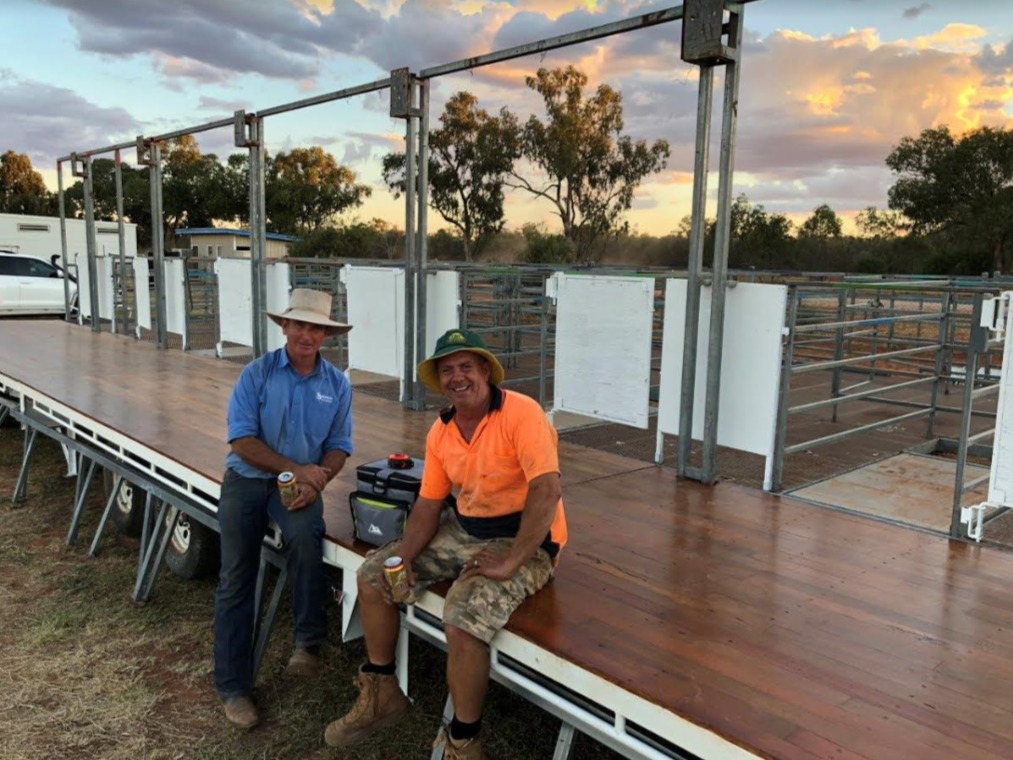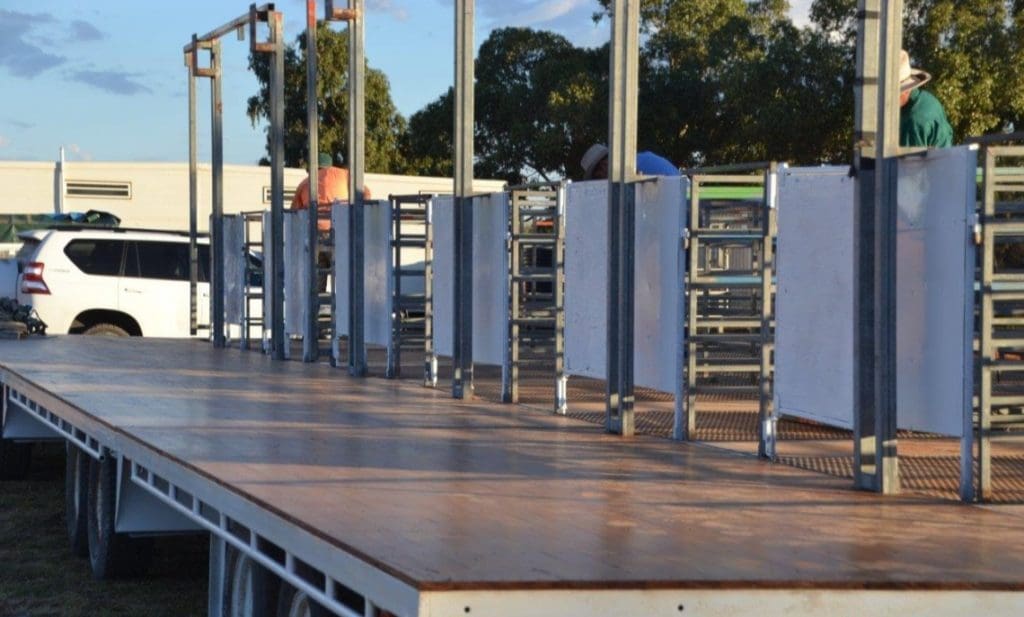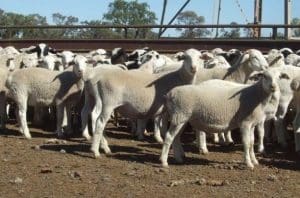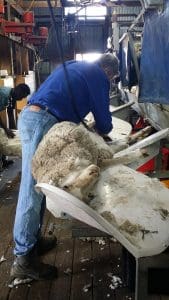
Rodwells Queensland wool manager Bruce Lines, left, with former Sports Shear Queensland president Michael Nancarrow with the portable shearing board ready to go.
QUEENSLAND’S wool industry is exploring new ways to get their sheep shorn despite failing shed and yard infrastructure in some areas.
Some western Queensland graziers are putting shedding or cleanskin sheep such as Dorpers behind exclusion fencing, rather than Merinos, to eliminate wool-related management tasks and issues such as mulesing and flystrike.
But in many areas ongoing dry conditions, lack of rain and labour, rather than competition from other breeds, are still regarded as the main obstacles to maintaining and rebuilding the state’s wool flock and getting the clip harvested.
In the Australian Wool Production Forecasting Committee’s latest report last month, Queensland’s shorn wool production for 2019/20 was estimated at 6.73 mkg, down 17.3 percent on 2018/19. The number of sheep to be shorn in Queensland in 2019/20 is forecast to drop to 1.8 million, down from 2.2 million in 2017/18.
Australian Wool Innovation-funded network Leading Sheep is working with Queensland growers to overcome infrastructure challenges and the levy-funded research, development and marketing company said wool harvesting is a key investment focus.
Longreach contractor Tully Bowden said reduced Merino numbers had led five contractors to leave the area, but he and his daughter Rayleen had managed to keep shearers working by taking over their work. His workers were shearing about 240,000 sheep a year, versus about 400,000 10 years ago with two teams.
He agreed many graziers had allowed their sheds, yards and staff accommodation to fall into disrepair, which was probably limiting restocking with Merinos.
“It probably is, because it would take a lot of money to repair the infrastructure needed to shear.”
He believed the wool and sheep meat markets were good enough to encourage people back into Merinos, but it was hard to source sheep, and many graziers were stocking Dorpers behind exclusion fences.
“The Dorpers have a bit of a grip – because they are less work — but I don’t think they are making the profits of a Merino.”
Mr Bowden said crutching on mobile trailers was “alright”, although they didn’t produce as good a result as across the board, but he didn’t this was feasible for shearing. Training new staff was also an issue.
Could more mobile shearing trailers be a solution for some?

The portable trailer-mounted Sports Shear Queensland shearing board.
Rodwell’s Queensland wool manager and Leading Sheep committee member Bruce Lines at Roma said use of Sports Shear Queensland trailers used for shearing competitions could be expanded to shear sheep on properties without infrastructure.
“Sports Shear Queensland has three trailers that make up six stands that we use for shearing competitions that can quite adequately be used in a big hayshed or under a tent or marquee to shear sheep.
“It is just like the pens and stand that are in a wool shed, there is just no shed to go over it,” he said.
“They are available for rent or hire anytime.
“There are two stands per trailer, they are legal width and you can tow them with a four wheel drive and they all join together as six-stand raised board.”
He said former shearing contractor at Cunnamulla Charlie McKenzie has used the trailers to shear thousands of sheep in the hay shed of a station owner getting back into Merinos. The concept could be duplicated across the state where required and even applied to provide portable accommodation for shearing and shed staff.
“There is no reason why you couldn’t put the same sort of set up on a low loader.”
Rainfall still the main obstacle to restocking
Mr Lines said he had seen Dorpers come and go in the country between Winton and Goondiwindi, and around Cunnamulla.
“I couldn’t say that they are outnumbering the Merinos in Queensland.
“The numbers of wool sheep in Queensland are low, but I don’t think they are outnumbering the Merinos in the state.”
Mr Lines said the main obstacle to people restocking with sheep is lack of rain, with wool growers preparing to reduce their flocks again if there is no rain by January.
“The ongoing dry is what is affecting the wool growers, and us as wool agents, we are feeling it just as much as the clients at the moment.
“People are on the edge of their seats — I believe people are waiting on this rain the get back into Merinos, they really are,” he said.
“The sentiment I get from my growers is that the money is good in meat and in wool, and if there is an animal to get back into it would be the Merino.”
Mr Lines said his clients around Blackall had double-joined ewes to lift numbers quickly in the past.
“When there is a season and a half, people can double join.”
He said the ability to control grazing pressure on land behind exclusion fences was already helping wool producers to maintain numbers despite the dry conditions.
One client joined 1500 ewes to get 1200 lambs this year behind an exclusion fence, but might have to reduce ewe numbers if rain did not fall soon.
“Even though it is dry he is maintaining his ewe numbers.”
Mr Lines said Australian Wool Innovation also had some good plans and ideas for growers wanting to build new wool sheds or upgrade existing systems. The possibility of using neighbour’s sheds as ‘depot’ sheds for shearing sheep has been discussed.
“On a lot of properties there are shearing sheds not being utilised.
“Even the semi-trailer idea of Shear Express – just turn that into a shearing shed on wheels – it takes someone innovative in our industry like a shearing contractor to utilise that,” Mr Lines said.
“We shouldn’t be using AWI all the time, we should look to the innovation of our shearing contractors or our wool growers,” Mr Lines said.
“If there is a need for a shearing shed to be on wheels, someone will come up with it.”
Mr Lines said the shearing platform system was considered to be too expensive for large numbers in the pastoral areas and robotic shearing was still “pie in the sky stuff.”
Mr Lines said Queensland needed to “wind the clock back” to teach new entrants in the industry what was needed.
“It’s sad to say that we need to do that, but I know a lot of young guys who just won’t go near a Merino because they think they are just so much work.
“But the return is there and it outweighs cropping and cattle and everything in seasons like this,” he said.
“It is giving people some understanding and being educated on the industry that could pull us out of a hole.”
Dorpers coming into the ‘red’ country

Dorper lambs in Queensland.
Elders sheep and wool specialist at Toowoomba Peter Sealy said there was a big push into Dorpers among graziers on the ‘red’ country west of Cunnamulla, from Bollon and Charleville to St George, that previously ran Merino wethers.
“They’ve been out of sheep for a while and their infrastructure is dilapidated and now they’ve got the (exclusion) fences up they are going back into Dorpers or meat sheep, using portable sheep yards.”
But he said graziers in the western downs country around Longreach, Tambo, Blackall and Barcaldine were going back into Merinos and still had good infrastructure.
He believed people were choosing Dorpers for lifestyle and ease of care reasons, and they avoided flystrike and the need for mulesing.
“They are running them like little cattle, they are thinking they are easy case and the Charleville abattoir killing Dorpers as well as goats has been a big thing, they’ve got a very good market at their door step.”
Mr Sealy said the exclusion fences were allowing graziers to control grazing pressure on their land.
Mr Sealy said AWI-funded sheep classing days have been popular with many people coming back into the industry “thirsty for knowledge.” Growers at a Cunnamulla day were surveyed and more than half said they were going to increase their goat operation, he said.
“But on the other side of the coin, there was a Dorper day outside St George.
“They were expecting 30 people and 110 turned up, so that just shows what is happening in western New South Wales and Queensland.”
Platform concept is underutilised

An upright shearing platform in action.
Shearing platform developer Grant Burbidge said he had shorn about 130,000 on his ‘shear anywhere’ platforms in the past five years, but he is not promoting the option and enquiry has been limited.
“The biggest problem is finding people to work on them, we’ve never had one conventional shear who has adapted – you can’t teach an old dog new tricks.”
Mr Burbidge said he has sent platforms to producers who wanted to shear their own sheep and has had some enquiries from overseas.
“I will make equipment available for anyone who wants to use it, although it is not a long-term solution.”
He believes if conventional machine shearers were willing to be trained on the platforms, the system would be an option for properties with limited infrastructure.
“There is nothing wrong with the system, it is just a matter of finding the people willing to work on it.
“You can set it up anywhere – we just finished shearing 2000 sheep at Simpson – we just shore them in a machinery shed on plywood on the floor.”
No appetite for the return of Shear Express
 Leading Sheep last week ran a free shearing shed workshop in Longreach funded by Australian Wool Innovation. The half-day event targeted people thinking of building or designing a shed. It also provided tips and ideas on how to run a profitable shed. The day featured a question and answer session, photos, videos and floor plans of recently-built sheds, a discussion led by a local building contractor and finance options through Queensland Rural and Industry Development Authority sustainability loans. This is another strong indication AWI is committed to working with Queensland growers to overcome infrastructure challenges, AWI said.
Leading Sheep last week ran a free shearing shed workshop in Longreach funded by Australian Wool Innovation. The half-day event targeted people thinking of building or designing a shed. It also provided tips and ideas on how to run a profitable shed. The day featured a question and answer session, photos, videos and floor plans of recently-built sheds, a discussion led by a local building contractor and finance options through Queensland Rural and Industry Development Authority sustainability loans. This is another strong indication AWI is committed to working with Queensland growers to overcome infrastructure challenges, AWI said.
AWI said it had projects related to mobile shearing that in effect will address issues around lack of infrastructure. Aspects of Shear Express (eg. Delivery and upright shearing posture) have been further developed as part of other projects. At this stage there is no appetite to re-evaluate Shear Express, AWI said.
AWI spent more than $6 million on its mobile wool harvesting Shear Express project, before ceasing funding in 2003 after an independent evaluation and field trials confirmed the prototype unit had not met key design expectations and targets. More than 80 potential harvesting technologies were assessed by AWI, identifying promising areas for development including hand piece technology, parallel, modular, upright shearing platforms and alternative shearing technologies.
AWI also has an ongoing project with WASIA, developing Shearing Shed Safety Assessment tools and resources for wool grower and shearing contractors. AWI said research and development also continued on sheep delivery systems, upright shearing and efficient shed and yard designs – all aimed at improving the health & safety of shed staff.

A “portable shearing board ready to go.”…wow…seems to be a few things missing on that score…setting aside the sheep. No gear is one.
Apart from that it, this arrangement could not possibly considered meeting OHS requirements. I would like to see a plan and then comment further.